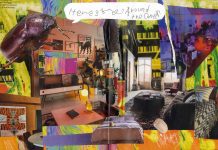
A high heel was a rook; a ballet flat, a pawn. Maria Ferrara lined the ends of her chessboard, an old drop cloth painted with a checker pattern, with old discarded shoes — unlikely chessmen.
“I am not a chess player, so I decided to relate it to life,” Ferrara, a sophomore undeclared major, said. “I am trying to depict how, when we take steps in life, it can be damaging, or it can be good. It’s the same in chess, each move you make is very dependent on what your next move is going to be.”
Ferrara made the unusual chessboard for adjunct faculty members Douglis Beck’s 3D Design class. Beck, inspired by the recent news of a nationally-renowned chess team moving to Webster University in June, assigned his class to create a chessboard of their own as a project for his class.
“I’ve always thought about it,” Beck said, “And thought it would be cool to make chess sets. This opportunity presented itself.”
Beck said none of his 3D Design students had heard of Webster’s incoming chess team.
“There was a gap where I had to impress on them, ‘This is actually a really big deal.’ It was really just the right thing at the right time,” Beck said.
Beck allowed students to use any materials they wished to construct their chessboards. Alex Guerra, freshman lighting design major, has begun constructing his chessboard on the old hood of a BMW, using spare car parts as the chessmen. Punnaiat Jaliya Watwong, a senior animation and media major, is carving his board into a piece of leather.
“The limitations are the rigor of their thinking,” Beck said.
Beck has outlined, however, that the boards must be practically playable.
“When you’re designing something, there are certain limitations based on the use of that thing,” Beck said. “Or the person that you’re making it for, the materials that you’re using. In order to elevate those designs really to the level of art, you have to completely understand those constraints and be able to work fluidly with them.”
Before his students began work on their boards, Beck spent one class just teaching them how to play chess.
James Kolditz, freshman lighting design major, began playing chess at a young age after his father taught him. His chessboard construction was an adaptation of a chessboard made in the 1920s, in the Bauhaus style.
“It’s actually my favorite project that we’ve done here,” Kolditz said. “I’ll probably give it to my dad when the semester is over.”
This assignment is the fourth, out of typically six or seven, projects Beck has assigned his class this semester.
The boards will be displayed from March 7-20 in the front hallway of the Visual Arts Building. Beck said he welcomes all to view and play on the boards.
“This form and function thing has gotten out of control,” Beck said, quoting St. Louis artist Charles Eames. “Who’s to say pleasure and fun aren’t some function of design as well?”



